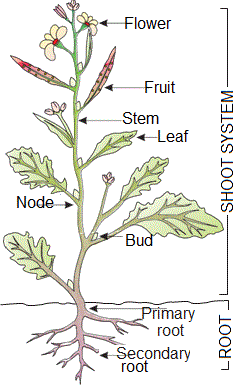Shoot system in flowering plant
The word 'Shoot' generally is used for the main stem.
A plant has many complicated and complex systems that keep it living and growing including the shoot system.
The shoot system in a plant, generally refer to the leaves, buds, flowering stems and flowering buds including the main stem itself.
Structure of the shoot system
From the ground surface to the terminal bud (end of the undeveloped shoot) there is nodes and internodes.
Nodes are the points where leaves are attached and internodes are the places on the stem between the nodes.
In the crux created by the node and stem there are axillary buds that lay dormant having potential to grow a vegetative branch.
These axillary buds lay dormant because of apical dominance.
This is a phenomena where the plant concentrates most of its resources at the terminal bud. The terminal buds grows at the apex, or tip of the plant.
This is responsible for making the plant grow taller and bigger so it makes sense that the plant would want to concentrate resources here.
In the case terminal bud gets damaged then axillary buds will 'wake up' and begin to grow and save the plant.
When axillary buds begin to grow then they can create their own terminal buds, leaves, etc. that can create a secondary plant themselves.
The leaves of the plant act as the photosynthetic factory for plant, producing sugars and other compounds for the plant to survive on.
There are many different types of leaves, but most will include a blade, stalk, veins and the petiole. The stalk is the main stem of the leaf, the blade is the actual green leaf portion, and the petiole is where it attaches to the node.
The veins are similar to our veins in that they carry water and nutrients out into the leaf.

Theories regarding the organisation of the shoot apex
1. Apical Theory
Apical Theory was given by Karl Nageli and Hofmeister.
As per this theory a single apical cell is responsible for the development of all the aerial plant parts.
Apical theory holds good for some cryptogams, such as bryophytes, some higher algae and some pteridophytes.
2. Histogen Theory
Histogen theory was proposed by Hanstein. As per this theory, the shoot apex does not comprise a single apical cell or a group of meristematic cells that are responsible for the development of the whole plant body.
As per this theory, the apical meristem consists of three distinct zones of meristematic cells called Histogens which are as follows:
| Dermatogen | Periblem | Plerome |
|---|---|---|
| It is the outermost layer and gives rise to the epidermis. | It is present below the dermatogen and gives rise to the cortex and endodermis. | It is the inner core that gives rise to vascular tissues and pith. |
3. Tunica-Corpus Theory
Tunica-Corpus theory was given by Schmidt to describe the organisation in a shoot apex. As per this theory, the apical region of the shoot consists of two zones as follows:
| Tunica | Corpus |
|---|---|
| It is the outer enveloping layer made up of small cells that give rise to the epidermis and outer cortex. | It is the mass of cells forming the inner core. It produces the inner cortex, procambium and pith. |
